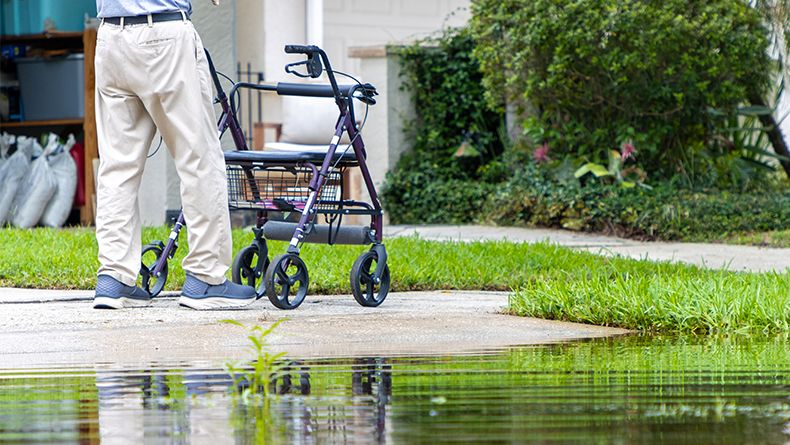AARP Hearing Center
Hurricanes Highlight Importance of Disaster Preparedness
By Paul Lingamfelter, Christy Kwan, October 31, 2024 11:00 AM

As states and communities continue to recover from the devastation caused by Hurricanes Helene and Milton, many are left wondering what could be done to prevent large-scale destruction from such disasters. Despite the severity of those storms, they were only the most recent among several to sweep across the Southeastern states. Moreover, hurricanes are only one of numerous natural disasters that are increasingly common.
And many community leaders and disaster experts are looking to strengthen natural disaster prevention, protection, and mitigation practices. That’s an encouraging trend because developing those practices, and specifically creating mitigation plans, can make a big difference.
Impact and increased planning
As hurricanes and other high-cost disasters continue to occur, many stakeholders are calling for more attention and funds to be directed toward hazard mitigation. State, tribal, and local governments develop hazard mitigation plans, sometimes called multi-hazard mitigation plans, to reduce the loss of life and property by minimizing the impact of disasters. These hazard mitigation plans are created by identifying natural disaster risks and vulnerabilities to their area and consist of long-term strategies governments can implement to protect people and property from potential hazards.
To be most effective, emergency and hazard mitigation plans need to include components that address the needs of people of all ages and abilities. Older adults receiving support from a family caregiver, a home care aide, or in a nursing home may be particularly vulnerable in disaster situations. In addition to short-term safety, such an event can have lasting consequences on their physical and mental health, economic security, and overall well-being. Extreme hot or cold temperatures harm older adults faster than people under 65, and disasters disrupt caregiving drastically. States and communities need to identify natural hazards to which these populations may be most susceptible and develop and implement strategies to reduce their vulnerability.
Mitigation plans as part of sound community-building
Hazard mitigation plans can vary in design, including whether and how they address the needs of older adults. Efforts to measure community livability and the quality of long-term services and supports (LTSS) should incorporate these plans. The 2023 AARP LTSS State Scorecard included an indicator of state emergency preparedness. It credited states that had a Federal Emergency Management Agency (FEMA)-approved enhanced state hazard mitigation plan that included a social vulnerability index to better identify its populations most vulnerable to disaster.
Beyond protecting their residents, states and communities have a financial incentive to have hazard mitigation plans in place. According to the National Institute of Building Sciences, hazard mitigation saves up to $13 for every $1 invested. States with a FEMA-approved enhanced plan are eligible to receive an additional 5 percent in Hazard Mitigation Grant Program (HMGP) recovery funds in the event of a disaster.
Similarly, the AARP Livability Index™ platform gives credit to communities with FEMA-approved multi-hazard mitigation plans. Whereas state-level officials will utilize the state hazard mitigation plan during a time of disaster, the community and local-level officials will utilize their community-level hazard mitigation plan. When a community is covered by both state and local hazard mitigation plans, state and local leaders can refer to both documents to promote synergy and efficiency in coordinating recovery efforts and resources.
Data shows that some states and many communities are demonstrating belief in planning. Out of 16 states that currently have a FEMA-approved enhanced hazard mitigation plan, the LTSS Scorecard only awarded credit to the nine that utilized a social vulnerability index. Meanwhile, the 2024 AARP Livability Index™ data just released this month found that 83 out of the 100 top-performing communities[1] fell under the jurisdiction of a FEMA-approved local or regional hazard mitigation plan.
Proven approaches
Having a hazard mitigation plan doesn’t prevent a disaster from occurring, but a more prepared community will protect its residents better. Fortunately, most of the communities hit hardest by Hurricanes Helene and Milton have a local hazard mitigation plan in place. Three of the hardest-hit states, Florida, Georgia, and North Carolina, are all among the 16 states with a FEMA-approved enhanced state hazard mitigation plan. It is fortunate, and probably no coincidence, that these three Atlantic coast states have previously demonstrated how seriously they take disaster prevention and recovery.
The recent hurricanes have brought great tragedy and suffering to a region all too familiar with such events. Fortunately, the region had already begun to think in terms of mitigation and planning. For other communities looking to strengthen their approaches, AARP and FEMA collaborated to create the AARP Disaster Resilience Toolkit, which, among other recommendations, encourages communities to develop mitigation plans that continuously strive to identify risks and potential responses and bring all stakeholders together. To be sure, having a good mitigation plan in place represents a proven approach to lessening the impact of these disasters.
[1] Top 100 analysis conducted by reviewing the top-performing 25 communities from each community size within the AARP Livability Index™ platform. Community sizes are defined as very-large (population 500,000+), large (population 100,000 to 499,999), mid-size (population 25,000 to 99,999), and small (population 5,000 to 24,999).

































































